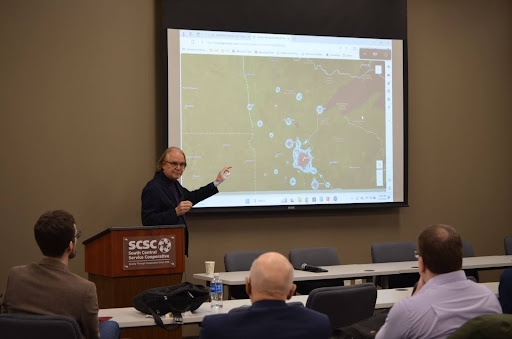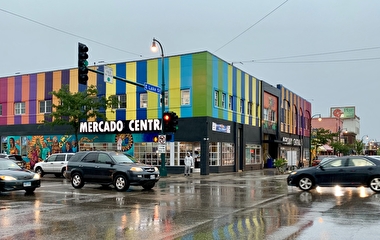
About an hour’s drive southwest of the Twin Cities metro, North Mankato may not leap out as the most likely place for more than 60 industry, economic development, research, and transportation leaders to examine the economic and transportation impacts of Minnesota’s medical device industry. However, to attendees of Industry Clusters on the Prairie: Economic Drivers in South Central Minnesota, the location was ideal. That’s because it’s in the heart of what new research highlights as a “cluster” for Minnesota’s medical device industry.
“Seeing is believing, and maps [of the medical device industry cluster] help us see that ‘Medical Alley’ is not a narrow corridor—it’s a series of counties in Minnesota,” said Rick Bauerly, founder and CEO of Granite Partners. “There is a fabric of supply chain outside the Twin Cities that is feeding the medical device industry, and this visualization can help us see it more, know it more, and invest in it more in the years to come.”
The daylong event was presented by CTS, the Transportation Policy and Economic Competitiveness (TPEC) Program, and the Region 9 Economic Development Commission.
TPEC researcher Tom Horan, a visiting scholar with the U of M Humphrey School of Public Affairs and the dean of the School of Business at the University of Redlands, delivered the keynote presentation—a look at new research into the medical device industry cluster throughout Greater Minnesota. Horan’s presentation featured both an interactive StoryMap of the cluster and a case study of Granite Partners. “What is distinctive about this case study is that it focuses on how industry clusters can drive a business strategy and do so in a manner that has positive implications for communities,” Horan said.
Read an in-depth summary of this new research.
Following Horan’s presentation, Bauerly and Horan joined Region 9 Economic Development Director Kristian Braekkan for a panel discussion focused on the implications of the research for Greater Minnesota.
“Clusters aren’t easily visible because you not only have to understand the direct supply chain but also the indirect supply chains—however, our economy wouldn’t function wi…thout them,” Braekkan said. “Clusters are important because they foster industry diversity and economic resilience, pull resources in for entrepreneurship, become a draw for human capital, and create an economy that is greater than the sum of its parts.”
The panel fielded questions from attendees on a range of topics including how to better identify clusters, preserve linked local industries such as health care and childcare, identify and fill gaps in the supply chain, and encourage more local production to reduce the risks inherent in global supply chains.
Following the first panel discussion Patrick Kelliher, outreach director for US Senator Amy Klobuchar, introduced a video message from the Minnesota senator. “I look forward to hearing about the outcomes of this event and what Senator Klobuchar and her office can do to further the economic and community development of this region,” Kelliher added.
In her address, Senator Klobuchar highlighted the recent federal designation of Minnesota MedTech 3.0 as a U.S. Department of Commerce Tech Hub, legislation to ensure fair prices for ocean shipping, removal of the medical device tax, advocacy for timely and safe approval of medical devices, and support for increased access to apprenticeship programs. In addition, Klobuchar reiterated the importance of keeping more of the supply chain in Minnesota, particularly for semiconductor chips.
“To keep our economy strong, I want to make sure all parts of Minnesota …have the support they need to thrive,” Klobuchar said. “This means strengthening Minnesota’s competitive edge. One way to do that: bringing semiconductor chip manufacturing back to the U.S. Chips are in everything from the planes in the sky to the phones in our pockets to the medical devices so many people rely on, and they will be critically important to developing the technologies of the future.”

In the afternoon, the focus shifted to transportation and logistics with a panel discussion focusing on goods movement, supply chain, and economic impacts surrounding Horan’s research on clusters. Andrew Andrusko, MnDOT statewide planning director with MnDOT’s Freight Office, launched the conversation by emphasizing the importance of health in the state’s transportation plans.
“We want to understand how freight moves and how we can supply goods and services to our people and communities, and medical supplies and other types of medical equipment are one of our state’s key exports,” Andrusko said. “Also, health isn’t just about what moves and where it moves—it’s about how emissions and sustainability affect our health, and how we should invest for our future transportation system as we think about these issues.”
Agricultural products are another of Minnesota’s key exports. Patrick Hessini, vice president of agribusiness cooperative CHS and CTS Executive Committee member, highlighted some of the contrasts between transporting specialized medical devices and Minnesota’s agricultural supply chain. “In agriculture we are primarily shipping commodities, which are very different than the medical device space,” he said. “The transportation performance and cost structure can make or break our business and the value that we bring our owners.”
Bob Kill, president and CEO of manufacturing business consultants Enterprise Minnesota, explained that the biggest challenge for Minnesota manufacturers is human capital: attracting, retaining, and investing in leaders. Additionally, he echoed the need to keep supply chains more local. “We learned during COVID that long-distance supply chains are problematic, so anything we can do to bring that back closer to home is really a benefit to our state—we need it across the entire state, not just in the metropolitan area.”
Following the panel discussion, CTS Director Kyle Shelton and Nicole Griensewic, Region 9 Development Commission Executive Director and CTS Executive Committee chair, concluded the event with a call for continued cooperation and collaboration. “In thinking about the systems that are allowing these clusters to form and grow, it’s clear that transportation and infrastructure are essential,” he said. “However, it’s also the more intangible bonds like the relationships formed among partners, and I’m eager to continue exploring those with everyone here today.”
The event was part of the CTS Rural Needs, Statewide Answers campaign, a year-long effort to highlight issues in rural transportation—as well as research that seeks to better understand and address them.
—Megan Tsai, contributing writer


